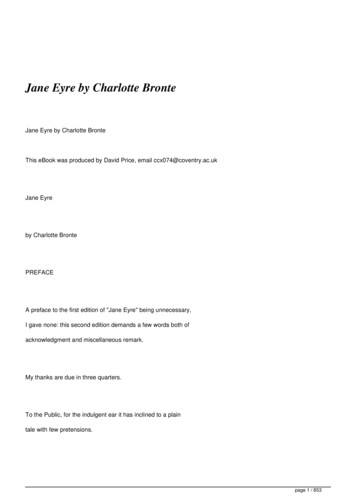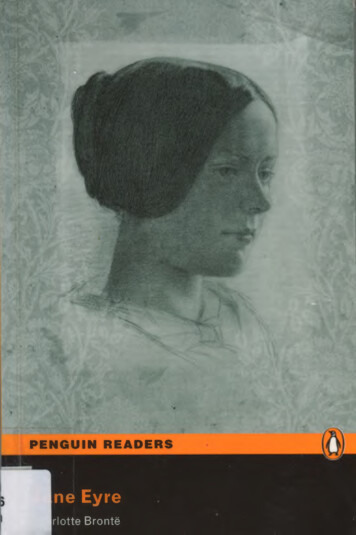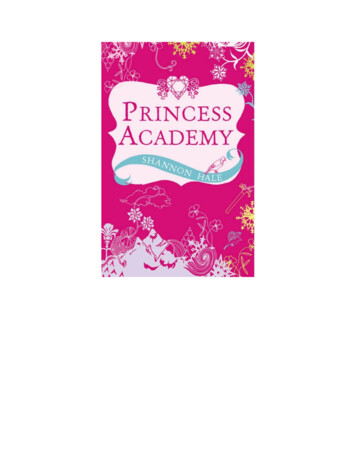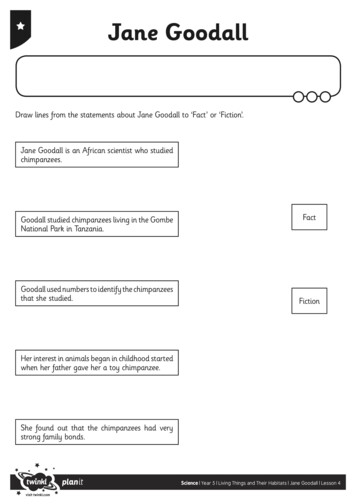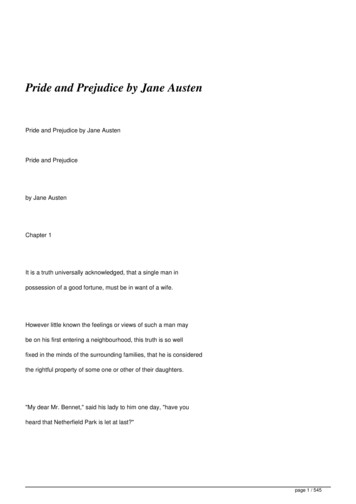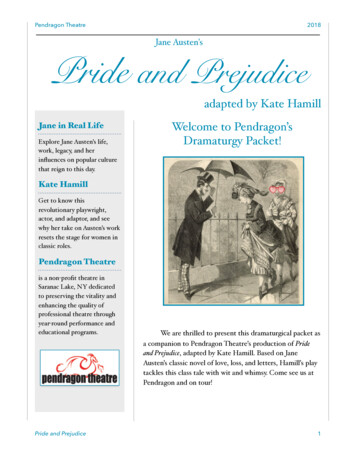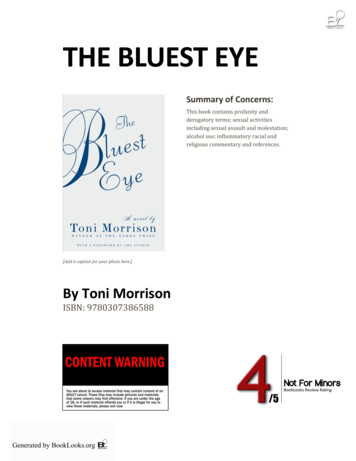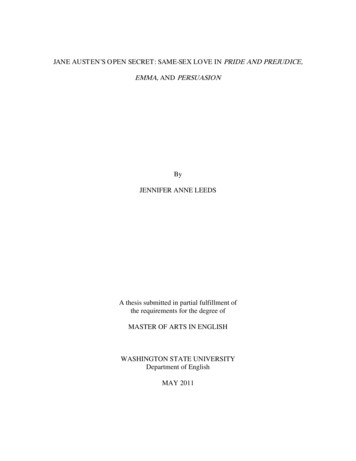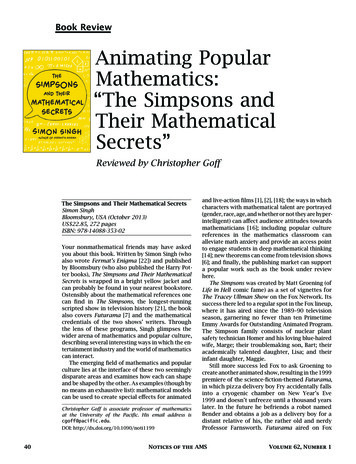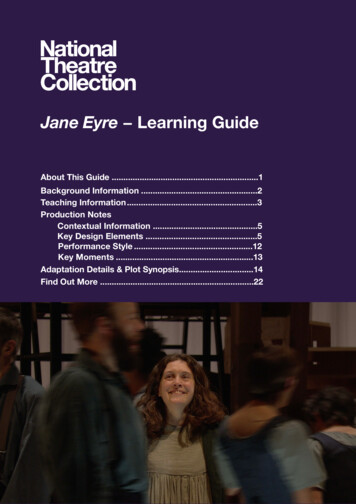
Transcription
Jane Eyre Learning GuideAbout This Guide .1Background Information .2Teaching Information .3Production NotesContextual Information .5Key Design Elements .5Performance Style .12Key Moments .13Adaptation Details & Plot Synopsis.14Find Out More .221
Jane Eyre Learning GuideAboutThis learning pack supports the NationalTheatre’s production of Jane Eyre,directed by Sally Cookson, which wasoriginally staged at the Bristol Old Vic andopened on the 24th September 2015 atthe National’s Lyttelton Theatre in London.Our packs are designed to support viewingthe recording on the National TheatreCollection. This pack provides links to theUK school curriculum and otherproductions in the Collection. It also has aplot synopsis with timecodes to allow youto jump to specific sections of the play.Here you’ll also find all the information youneed to enable you to study theproduction and write about it in detail.This includes notes about all of the keyelements from performance style todesign. You’ll also find pointers for furtherresearch.1
Jane Eyre Learning GuideBackground InformationRecording Date – 8th December, 2015Location – Lyttelton Theatre, National TheatreAge Recommendation – 12 (some strong language)CastMr Brocklehurst / Pilot / Mason.Craig EdwardsHelen Burns / Adele / St JohnGrace Poole / Abbot . Laura ElphinstoneRochester .Felix HayesBertha .Melanie MarshallBessie / Blanche IngramDiana Rivers. Simone SaundersMrs Reed / Mrs Fairfax . Maggie TagneyJane Eyre. Madeleine WorrallMusician .Phil KingMusician . Will BowerMusician .Benji BowerOther parts played by members of the CompanyCreative TeamDirector . Sally CooksonAuthor . Charlotte BrontëSet Designer . Michael ValeMusic and Musical Director . Benji BowerLighting Designer . Aideen MaloneCostume Designer . Katie SykesMovement Director .Dan CanhamFight Director . Renny KrupinskiSound Designer . Dominic BilkeySound Designer . Mike BeerDramaturg . Mike Akers2
Jane Eyre Learning GuideTeaching InformationThis production is particularly suitable for: English Literature studying the novel for GCSE or A Level. Drama and theatre students with an interest in devising. Anyone with an interest in the adaptation of novels for the stage.In particular you might like to explore: How a first-person narrative is adapted successfully for the stage. How the company work together as an ensemble and interact withproduction and design elements to tell the story. How the choice of music in the production supports thestorytelling. The relevance of Jane Eyre for a contemporary audience andwhether it is important to tell this story on stage.There are a number of other productions in the National TheatreCollection that relate to this one, which you and your students may wishto explore alongside it.Other adaptations of novels for the stageProductionDate AdaptationDirectorTreasure Island2014Bryony LaveryPolly FindlayPeter Pan2016The CompanySally CooksonFrankenstein2011Nick DearDanny BoyleSmall Island2019Helen EdmundsonRufus Norris3
Jane Eyre Learning GuideTeaching InformationOther devised productionsProductionDateDirectorPeter Pan2016Sally CooksonOther productions featuring members of the same creative teamProductionDateArtistPeter Pan2016Sally Cookson - DirectorPeter Pan2016Michael Vale - Set DesignerPeter Pan2016Katie Sykes - Costume DesignerPeter Pan2016Dominic Bilkey - Sound DesignerPeter Pan2016Benji Bower - MusicPeter Pan2016Mike Aykers - DramaturgPeter Pan2016Dan Canham - Movement4
Jane Eyre Learning GuideProduction NotesThe following notes have been compiled to help guide you through the significantdesign and performance aspects as you watch the production, or to remind youof them after you have watched it. You will also want to make your own notesand form your own opinions on the effectiveness of these aspects as you explorethe production.Contextual Information The original novel was published in 1847. Sally Cookson has spoken widely(including her introduction to the theatre programme) about the fact that thisis a play about human rights and needs, not just about “a girl who marriesher hunky boss”. Cookson wrote a helpful article which is available here. It is important to note that the adaptation reinstates the subheading of thenovel, ‘An Autobiography’. Many adaptations miss out Jane’s early life, butCookson feels that these experiences help form her character and thereforechose to retain them in this adaptation.Key Design Elements: Set The set consists of a large raised platform, a ramp, a rear platform whichspans the width of the stage, and various ladders of differing heights andangles. One ladder, nearest centre stage, is a completely vertical ladder andpresents a lot of challenge to actors, particularly those wearing corsets andlong skirts. Not only does this non-naturalistic set represent the five key locations in theplay (Gateshead, Lowood, Thornfield, Moor House and Ferndean, theladders can also be interpreted as the differing obstacles that Jane mustnavigate throughout her life. The downstage half of the stage is left empty for ensemble playing and forsmaller items of set, such as Rochester’s leather armchair and Mrs Reed’swheelchair. Some scenes also utilise the space underneath the largeplatform, and with the use of lights from above can give the impression ofbars or other methods of imprisonment.5
Jane Eyre Learning GuideProduction Notes The space directly in front of the rear platform is utilised by the band,including a baby grand piano made of brown wood to blend in with thewooden set. The floor is a light wooden floor, the set construction is of pine colouredwood. The ladders are dark iron. The height of the main platform is used in various different ways, such as aplace from which Mrs Reed speaks down to Jane, representing MrBrocklehurst and St John Rivers’ pulpit, and Jane’s classroom. The differencein status between Jane and the many adults in her early life is often madeobvious through use of this platform. A white curtain/backcloth surrounds all three sides of the stage and is reactiveto the lighting – it is the main way in which setting (particularly time of day) ismade clear to the audience. Three portraits are flown in stage right during the scene in the red room atGateshead. Note the use of a trapdoor down stage centre when characters such as MrReed, Helen Burns and Mrs Reed die. It is also used in the red room scenewhen Jane thinks she is being haunted by her uncle.6
Jane Eyre Learning GuideProduction NotesKey Design Elements: Costume Due to the ensemble nature of the play, various actors must multi-role. Theytherefore wear a ‘base layer’ to which they can add additional itemsdepending on their character. Jane herself wears a white smock dress, over which she wears differentdresses depending on her age and location. Jane also wears black leatherappearance boots. Mr Brocklehurst is made even more imposing by the height of his stovepipehat. He wears a black overcoat, black trousers and black boots, with a blackcravat. The Reeds (Mrs Reed and her two children) wear grey dresses/trousers. Thegirls wear mustard coloured ribbons in their hair which matches the golden/mustard shawl worn by Mrs Reed. John wears a cap and jacket. Theseitems appear to be silk to reflect the wealth of the family and contrast thedrab clothes that Jane wears as the poor relation in the family. Bertha remains in a red, corseted dress with puffed, short sleevesthroughout the performance. Although she wears a white gown in the novel,it conveys the idea of passion, fire, madness, desire and danger to theaudience through the connotation of the colour. Bertha and Rochester arewealthy and so her dress is made of rich silk-type fabric. Bessie wears a white mob cab and a white apron over her blue-grey dressto reflect her servant status. It has a square neckline. Children at Lowood wear rough brown smocks which suggest discomfortand lack of individuality. Costumes flown in above the main set give the impression of more peopleon stage than there actually are. One actor also plays Pilot, the dog. As well as being in his ensemblecostume of blue shirt and dark trousers, he also carries a leather strap whichhe thumps on the floor to represent Pilot’s tail.7
Jane Eyre Learning GuideProduction Notes Window frames are flown in (3x2 panes) to represent the many windows ofThornfield. In Jane’s classroom and in her room in Thornfield, members ofthe ensemble hold individual ‘panes’ which they place together and apart toshow the window either being opened or closed. Rochester wears a burgundy and gold waistcoat, dark checked trousers, along black coat (external scenes) and often carries a whisky tumbler as aprop.8
Jane Eyre Learning GuideProduction NotesKey Design Elements: Lighting Several focused spotlights – one down stage centre and one downstageright. These represent the red room (DSC) and locations such asRochester’s study (DSR). Warm general wash used to represent daylight and external locations. Red, purple of dark blue light is cast on the backcloth to suggest night-timeand to suggest mood and atmosphere. Note the use of shadow, created by lighting behind actors, particularly thosestanding on the platform, to suggest how imposing or intimidating they are. In moments where either Jane or Bertha are imprisoned or restricted, theplatform is lit from above which casts the outlines of ‘bars’ on to the floor. Flame is used in various locations (the back platform and several areas ofthe ramp for the two scenes where Bertha sets fire to Thornfield). Handheld lanterns which are used by individuals to create the impression ofwalking through candlelit corridors, and also a ‘fire’ at which Jane warmsher hands. Individual bulbs are also suspended above the stage, creating theimpression of stars in external locations, or candles during scenes duringinternal locations.9
Jane Eyre Learning GuideProduction NotesKey Design Elements: Sound Recorded sound effects such as thunder and rain during the scene atGateshead. Echo and amplification for various moments where Bertha sings. Choral and solo singing such as Kyrie (a Christian liturgy). The score also includes a ballad created from verse in the original novel (withthe refrain ‘poor orphan child’. Songs such as Gnarls Barkley’s Crazy, Noel Coward’s Mad About The Boyand Elvis Presley’s My Jesus Knows Just What I Need. Underscoring occurs during various scene to create mood and atmosphere. Rhythm and percussion is important, particularly during the ‘set pieces’ ofJane’s various carriage journeys. It creates a strong and insistent beat toaccompany the ensemble running on the spot. Recorded voices create a sense of chaos or sinister atmosphere, for exampleat the beginning of Act Two. Bertha’s laugh is often heard as an amplified orechoed sound. As well as songs with lyrics, the score uses choral singing or‘vocables’ (sounds like “ooh and ahh” that are not intelligible words).Key Design Elements: Wigs, Hair and Make-up As a child, Jane’s hair is down. As soon as she becomes a schoolteacher atLowood (and therefore an adult) she ties her hair up. Hair for the female characters is generally tied up (or worn short), and oftencovered by cloth caps or bonnets. Blanche Ingram wears a fascinator-style hair adornment.10
Jane Eyre Learning GuideProduction Notes The costumes communicate the 19th century origins of the original novel.However, dress lengths are shorter, particularly for the purpose of movingsafely around the set. Cookson wanted a contemporary feel to the productionand so the costumes are not completely full in terms of period detail, butsuggests the time in which the play is set. By making it more contemporarythrough use of colour, fit and length, the costumes help remind the audienceof the themes in the play that are still relevant today. Small items of costume allow ensemble to multi-role very quickly, for examplethe two female ensemble members who wear a black bonnet to signify theyare unnamed teachers at Lowood.Key Design Elements: Puppetry At the beginning and end of the play the ‘baby’ is created using a dress (atthe beginning) or a cloak (at the end).11
Jane Eyre Learning GuideProduction NotesPerformance Style This production was devised by the company, using the original novel andworking with a dramaturg (Mike Akers). Choral/ensemble work is vital, particularly in the use of ensemble voices atkey moments in the play to represent Jane’s inner thoughts. A close examination of the multi-role reveals that several actors playcharacters who are direct opposites to each other. For example, Mrs Fairfaxand Mrs Reed are played by the same performer, Helen Burns and St JohnRivers are played by the same person, and Rochester is played by the sameactor who plays John Reed. Scenes between Rochester and Jane are acted in a naturalistic style, but it isalways apparent this is a non-naturalistic production, given its use of multirole (including an adult male playing a dog), and the highly unusual set whichprovides various levels and performance areas. Movement is used at key moments to provide information without dialogue,for example the movement sequences at Lowood that show the mundane,repetitive and unpleasant environment and the way in which time passes. Song is used to mirror Jane’s inner feelings (such as Mad About the Boy asJane realises her true feelings for Rochester) and to add pathos as Berthasets fire to Thornfield (Crazy). Transitions between scenes are not always obvious due to constantmovement on set and/or music and soundtrack. Despite the tragedy and suffering in the storyline, there is a reliance oncomic timing – namely in the verbal sparring between Jane and Rochesterand the use of a man playing a dog.12
Jane Eyre Learning GuideProduction NotesKey MomentsYou might like to consider these key moments in particular when you arestudying the production. The opening sequence of the play in which Jane’s origins, the death of herparents and her childhood at Gateshead, for movement, motif andensemble work (also the use of a dress to create a ‘baby’ which is repeatedat the end of the play.(Start – 10 minutes) Travel set piece number 1 from Gateshead to Lowood. (22 mins 16 secs –25mins 48 sec) The use of window frames by the ensemble and Jane’s inner voice decidingto leave Lowood. (47 mins 10 secs – 49 mins 38 secs) The moment that Jane and Rochester are honest about their feelings, andJane’s “no net ensnares me” speech. (1hr 59 mins 40 secs) The ensemble prepare Jane for her wedding. As well as helping her put onher dress, this is a good example of choral movement, use of flying in andout of clothes on hangers. (2hrs 8 mins 40 secs) The wedding – an excellent example of the use of set. (2hrs 11 mins 10secs) Jane’s refusal to marry St John, the fire and Rochester & Jane reunited.This includes live flame, Crazy sung by Bertha, falling ash and thedestruction shown by broken window frames. (2hrs 32 mins 40 – end)13
Jane Eyre Learning GuideAdaptation Details & Plot SynopsisDifferences to Charlotte Brontë's originalThis adaptation of Jane Eyre condenses Brontë’s novel into just under 3 hours.While abbreviating many of the scenes, very little is altered of the original plot. The novel’s major characters Mr Lloyd, Miss Temple, Leah, Hannah,Rosamond Oliver and Mr Oliver are all cut. The subplot of the investigation into Mr Brocklehurst’s mistreatment ofstudents at Lowood is cut, or at least not directly alluded to. In the novel Jane’s first interaction with Mr Rochester takes place after shehas started at Thornfield Hall rather than on the way there. Jane’s correspondence with her paternal uncle, John, is cut, as is herinheriting of his large fortune. There is no mention in the play of Jane being related to St John. The subplot of Rosamond Oliver and Mr Oliver is cut. The child that Jane and Mr Rochester have at the end is changed from a sonto a daughter.Act One Prologue: A girl is born: Jane Eyre. Unable to support her, her parentsgive her away to her Aunt and Uncle Reed. Her Uncle is kind to her, but soondies, leaving her to the care of her Aunt.14
Jane Eyre Learning GuideAdaptation Details & Plot SynopsisAct One, Scene One (0:04:40): Sometime later, the young Jane is treated cruellyby her Aunt while she showers the other children with affection. Left alone, shefinds sanctuary in reading books about the world and natural history. Her cousin,John, finds her reading his book and hits her with it. She retaliates, biting him.Aunt Reed sends Jane to the Red Room as punishment.Act One, Scene Two (0:09:17): Alone in the dark room, Jane laments her unjustsituation. The ghost of Uncle Reed visits her in a dream, but her screams are metwith no sympathy from Aunt Reed, who locks her inside.Act One, Scene Three (0:12:35): The nursemaid Bessie comforts Jane, sayingshe may enjoy going off to school. Jane says she doesn’t mind hard treatment, aslong as it is justified.Act One, Scene Four (0:15:52): Jane interviews with Mr Brocklehurst for a placeat his school, Lowood. He warns her of the threat of eternal damnation if she iswicked, and gives her a book: A Child’s Guide, to study. Alone, Jane stands up toAunt Reed’s treatment of her and insists she is set free by going to school. AuntReed agrees to let her go.Act One, Scene Five (0:20:26): Jane and Bessie say a tender goodbye to eachother as Jane leaves for school.Act One, Scene Six (0:22:16): Jane travels across the country to Lowood.Act One, Scene Seven (0:24:15): She arrives at Lowood and receives food, a bed,and her uniform.15
Jane Eyre Learning GuideAdaptation Details & Plot SynopsisAct One, Scene Eight (0:25:24): Jane begins her teaching at Lowood. Thelessons centre around fearing God’s judgement.Act One, Scene Nine (0:28:40): Jane befriends a fellow pupil: Helen Burns.She tells Jane how Lowood is an institution for poor, orphaned and abandonedgirls.Act One, Scene Ten (0:30:30): During a lesson Helen is punished for havingdirty nails, and is forced to wear a sign saying “Slattern” around her neck.Act One, Scene Eleven (0:32:04): Jane and Helen discuss life at Lowood. Janesays she would stand up to the teacher if she tried to hit her, but Helen arguesyou should learn to love your enemies and forgive.Act One, Scene Twelve (0:35:10): The students shiver in front of a meagre fire.Mr Brocklehurst hands out books to them; Jane drops hers on the floor.Brocklehurst makes an example of her in front of the others, making her standon a stool and calling her a servant of evil and a liar.Act One, Scene Thirteen (0:39:03): Jane is still on the stool. Helen brings herfood but she refuses. She says she pities Jane and insists there’s goodness inthe world. They break bread and eat together.Act One, Scene Fourteen (0:40:30): The months pass and Helen falls ill. Janesecretly visits her. Helen insists she is happy she’s going to God; Jane stayswith her as she dies.Act One, Scene Fifteen (0:44:54): Years pass by, and Jane grows to an adult.She is now a teacher, showing herself to be stern but fair. She looks out ofwindows at the ‘blue peaks’, becoming frustrated and feeling trapped atLowood. She advertises in the paper for a new role, and is accepted to aposition as a governess for Mrs Fairfax at Thornfield Hall.Act One, Scene Sixteen (0:50:45): At the approach to Thornfield, Janeencounters Mr Rochester for the first time. He has fallen off his horse butinitially rejects Jane’s attempts to help him. Eventually he lets her help himback onto his horse.Act One, Seventeen (0:53:35): Jane arrives at Thornfield and is greetedwarmly by Mrs Fairfax. A French girl, Adele, enters, and is delighted to learn16
Jane Eyre Learning GuideAdaptation Details & Plot SynopsisJane speaks French. Mrs Fairfax informs her that the owner, Mr Rochester, isaway, and the Hall has become neglected in his absence. She goes to bed.Act One, Scene Eighteen (0:57:02): The next morning Jane is exploringThornfield. She hears strange noises; laughter from the ceiling. Mrs Fairfaxdismisses it as one of the servants, Grace. Fairfax briefs Jane on Adele’scurriculum.Act One, Scene Nineteen (0:59:12): Jane begins her tutoring of Adele, whoresists speaking in English. Alone, Jane continues to feel restless; longing formore freedom. She hears the laughter again and briefly encounters Grace. MrRochester returns suddenly and Jane is informed he wants an update the next dayon how Adele’s learning is going.Act One, Scene Twenty (1:04:09): Jane tries to make Adele look presentable forMr Rochester. He enters but begins interrogating Jane rather than Adele. He isstern but shows interest in her eloquence and painting skills. They leave, and MrsFairfax explains Mr Rochester is troubled by family issues.Act One, Scene Twenty-One (1:09:01): Adele shows improvement, as she recitesher times tables to Mr Rochester in English. Jane observes Mr Rochester alone,as he stares off wistfully.Act One, Scene Twenty-Two (1:10:59): Later, Mr Rochester manner hassoftened, and he even brings Adele a gift. Jane and Rochester speak alone. Thehave a caged conversation, almost flirtatious but also stern and impersonal. Janeis able to stand up to Rochester’s arrogant manner, and they soon come to enjoyeach other's company. Rochester reveals Adele’s mother left him and the child foran opera singer. He also alludes to a past life and regrets that still haunt him.Act One, Scene Twenty-Three (1:19:22): Jane reflects on the evening withRochester, confessing she enjoys his peculiarity.Act One, Scene Twenty-Four (1:20:27): Jane awakes to strange sounds. A firebreaks out in Rochester’s bedroom. Jane runs to his aide and rescues him fromthe flames. He rushes upstairs and has a brief conversation with Grace beforereturning. He tells Jane to return to bed, thanking her for saving him.Act One, Scene Twenty-Five (1:24:05): The next day Jane meets Grace and theyhave a heated conversation. She tells Jane Rochester has left for a fortnight.17
Jane Eyre Learning GuideAdaptation Details & Plot SynopsisAct One, Scene Twenty-Six (1:25:00): Two weeks later, Mr Rochester returnswith Blanche Ingram, Lady Ingram’s daughter, whom he is courting. Jane isdevastated, and angry with herself for believing she could have been close withRochester.Act One, Scene Twenty-Seven (1:29:53): Richard Mason arrives from Jamaicalooking for Mr Rochester. Rochester is shaken by his arrival.Act One, Scene Twenty-Eight (1:31:45): Mason and a woman dressed in redcircle each other, before the woman bites him. Rochester and Jane help him andtake him away to hospital.Act One, Scene Twenty-Nine (1:33:42): The next morning, Jane insists Gracemust be sent away. Rochester again refers ambiguously to his past, beforerevealing he is going to marry Blanche.Interval18
Jane Eyre Learning GuideAdaptation Details & Plot SynopsisAct Two, Scene One (1:39:06): A soundscape of voices - memories from Jane’spast - is heard.Act Two, Scene Two (1:40:05): Jane receives news that Aunt Reed is ill and asksto leave to visit her. She adds that she believes Adele should go to school andshe wil seek different employment. Mr Rochester refuses to allow her to leave,but Jane insists her and Adele must leave Thornfield once he is married.Act Two, Scene Three (1:42:56): Jane returns to Gateshead and is greetedwarmly by Bessie. She reveals that her cousin John committed suicide, shatteringAunt Reed.Act Two, Scene Four (1:46:14): Jane visits Aunt Reed, who blames Jane for herdistress, saying she “infected” Gateshead. She gives Jane a letter from herpaternal uncle that she had kept from her, asking Jane to join him in Madeira.Aunt Reed dies cursing Jane.Act Two, Scene Five (1:51:10): Jane returns to Thornfield Hall and repeats to MrRochester her desire to leave.Act Two, Scene Six (1:52:50): Jane is reunited with Adele, who is overjoyed tosee her. Mrs Fairfax says she presumes Blanche and Mr Rochester will announcetheir engagement soon.Act Two, Scene Seven (1:56:25): One afternoon, Rochester baits Jane by sayinghow much he will miss her after getting married and how she will soon forget him.The normally self-controlled Jane reveals her feelings for him. Rochester is nowsure that Jane is genuinely in love with him, and he proposes marriage. Jane is atfirst sceptical of his sincerity, before accepting his proposal.Act Two, Scene Eight (2:02:39): Preparations are made for the wedding, withJane insisting she will not let Mr Rochester pay for any part of her dress, apartfrom her veil. At night a woman breaks into Jane’s room and rips the veil in two.Rochester dismisses this, asking her to trust him.Act Two, Scene Nine (2:08:20): Jane puts on her wedding dress and leaves tobe married.19
Jane Eyre Learning GuideAdaptation Details & Plot SynopsisAct Two, Scene Ten (2:11:40): During the wedding ceremony, Mr Mason and alawyer declare that Rochester cannot marry because he is already married toMason's sister, Bertha. Mr Rochester admits this is true: Bertha is a lunatic living inthe top floor of Thornfield Hall.Act Two, Scene Eleven (2:13:55): The group return to Thornfield, and Jane meetsBertha: the woman in red.Act Two, Scene Twelve (2:15:36): Mr Rochester explains to Jane how his fathertricked him into marrying Bertha for money. Once they met, he discovered that shewas rapidly descending into congenital madness, but rather than leaving her, hekept her locked away at Thornfield. He apologises for lying but she refuses to staywith him, telling him to forget her.Act Two, Scene Thirteen (2:23:57): Jane leaves in the middle of the night to getas far away from Thornfield as possible. She struggles to find work as factories donot employ women. She collapses, preparing for death.Act Two, Scene Fourteen (2:28:43): She is rescued by a clergyman, St John, andhis sister Diana. They nurse her to health, but Jane keeps her past a secret.20
Jane Eyre Learning GuideAdaptation Details & Plot SynopsisAct Two, Scenes Fifteen - Nineteen (2:32:35): Jane begins work as a teacher ata nearby village school, and she soon begins impressing the village with her workethic. She and St John become close and study together. St John proposes Janemarry him, and come to India with him as a missionary. Jane ponders hersituation, as Diana encourages her to go, as she has nothing else.Eventually she agrees to go, but only if she can be free and not marry St John.John angrily insists they must be married to go together. She decides not to go,but instead is compelled to return to Thornfield Hall. She returns to find Thornfieldon fire.Act Two, Scene Twenty (2:43:15): Ash falls from the sky as Jane observes theblackened ruins of Thornfield. Mrs Fairfax reveals Bertha set the Hall on firebefore jumping from a window, killing herself. Mr Rochester was still in the housewhen it collapsed and tried to save his wife. He survived, but is now blind. Janeand Rochester are reunited and reconcile.Time passes and they have a child together: a girl.The End21
Jane Eyre Learning GuideFind out moreReadThe Rehearsal Insights Pack, featuring the rehearsal diary fromthis production written by Staff Director Ellen Havard, and aninterview with director Sally Cookson.WatchJane Eyre: MusicJane Eyre: DevisingJane Eyre: Set DesignJane Eyre: CostumeJane Eyre: MovementAdapting novels for the stage - dramatists includingFrankenstein adaptor Nick Dear, Jane Eyre director Sally Cooksonand playwright Patrick Marber discuss the challenges of adaptingnovels for the stage.ListenNadia Clifford and Tim Delap discuss their roles in the production22
Jane Eyre Learning GuideFind out moreExploreMore materials relating to the production including the costumebible, poster, prompt scripts, programme, stage managementreports and more are held at the National Theatre Archive, which isfree to visit. Find out more gestions for Further ActivityRead the opening chapter of Jane Eyre. How faithful have Cooksonand her company been to the novel? Discuss to what extent youthink adaptations should be EXACTLY the same as the novel theyare inspired by.Visit the NT Archive to research other productions by SallyCookson, including Peter Pan (also available on NT Collection).Note in particular how the audience demographic (particularly agerange) and subject matter influence the performance style.Also available at the NT Archive is the press material – interviewsand rev
This learning pack supports the National Theatre's production of Jane Eyre, directed by Sally Cookson, which was originally staged at the Bristol Old Vic and opened on the 24th September 2015 at the National's Lyttelton Theatre in London. Our packs are designed to support viewing the recording on the National Theatre Collection.
